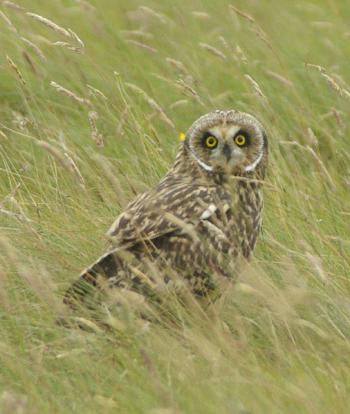Hawk-like owls
An owl that’s like a hawk? That would be the northern hawk owl, right? Well, yes, the hawk owl can be seen hunting during the day, like a hawk, and has the habit of sitting on top of a tree the way some hawks do (the American kestrel, for example). Northern hawk owls are year-round residents in northern Canada and Alaska and only rarely venture down to Maine in winter to grace us with their presence. Hawk owls are also usually not very concerned about human presence, presumably because they don’t have much experience with people in their remote northern environs; they will sit out in the open and allow observers to gawk at them for hours. Some readers may remember the bird that appeared in Bristol a number of winters ago (in 2009) that stayed for weeks, allowing hundreds of bird enthusiasts a chance to see and photograph it. No one has reported a northern hawk owl in Maine this winter as far as we know.
But another owl species that some might say is rather hawk-like in its foraging style has provided enjoyable sightings for many birders in the area. That species, the short-eared owl, is generally much more difficult to see and study than the hawk owl. While hawk owls are rarer, short-eared owls are shier and more elusive. During the day, short-eared owls like to stay hidden in thick grass, brush, or in a coniferous tree. Your best chance of seeing the species is right at dusk or dawn, when the birds come out to search for their rodent prey. They fly low over open grasslands or heathlands, stopping suddenly to drop into the grass when they see or hear a small mouse or other small mammal. This style of foraging is quite similar to hawks like the northern harrier (formerly known as the marsh hawk) and the rough-legged hawk—both hawk species that are also found in open grasslands and heathlands. In Upstate New York, where the two hawks and the short-eared owl are found wintering together, we have had the experience of watching over a wide open field and seeing the hawks seemingly turning into short-eared owls as the late afternoon turned to dusk. Short-eared owls have an unusually wide distribution occurring across much of northern North America, Europe, and Asia as well as parts of South America. In Maine, short-eared owls have occasionally been found breeding but are more regularly found wintering in the state, though only in small numbers and at scattered locations.
Other parts of the world have their own kinds of hawk owls. Australia has hawk owls with wonderful names like “boobook” and “morepork”—their names are based on human interpretations of their vocalizations. There are also eagle owls in other parts of the world, though they tend to look similar to our great horned owl. Some of the most intriguing types of owls are the fishing owls of Asia and Africa that actually catch and eat fish along with other creatures when they can.
Although “our” short-eared owl may not have as intriguing a name, it is fascinating bird. If you have the chance to see one, just be sure, like all owls and birds in general, to observe them from a respectful distance.





























.png)
.png)

